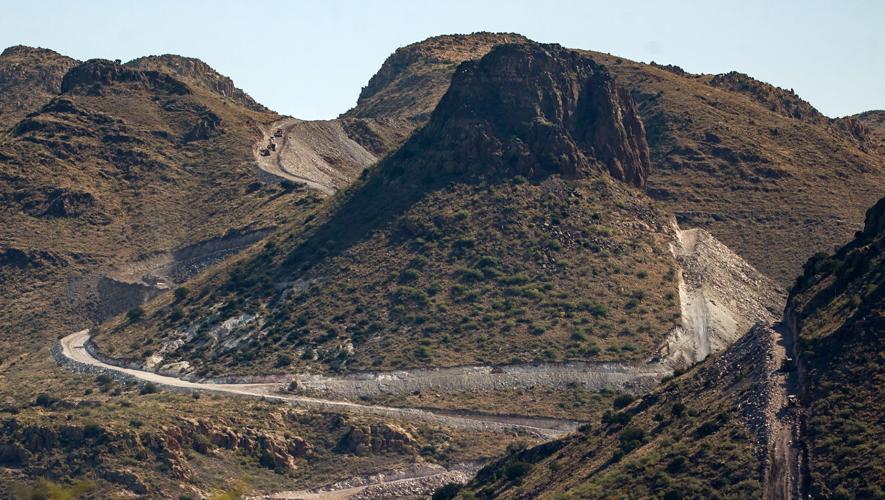From the New Mexico border to the Barry Goldwater bombing range, workers are busily destroying Southern Arizona’s borderlands.
Night and day, week after week, they’re blasting, grading, tearing up, digging down — all to throw up as much border wall as they can before President Trump leaves office Jan. 20.
It’s a disgraceful campaign of ecological destruction, carried out for profit in fulfillment of a political slogan: “Build the Wall.”
Many of the places where the wall is going up now — like Guadalupe Canyon in Cochise County, the Pajarita Wilderness in Santa Cruz County and the Tinajas Altas mountains in Yuma County — are largely impenetrable by vehicle and a very difficult climb and walk anyway, especially in summer. The wall itself is practically redundant there.
But the contractors have just this one shot to make their buck. Southwest Valley Constructors, a division of New Mexico-based Kiewit, has a $2.2 billion contract to build 88 miles of wall in southeastern Arizona. North Dakota-based Fisher Sand and Gravel is carrying out a $1.8 billion contract to build 74 miles of wall south and west of Tucson.
So they’re blasting rock, sucking up water and pouring concrete as the clock ticks down.
President-elect Joe Biden said in August: “There will not be another foot of wall constructed in my administration.”
The Army Corps of Engineers has estimated that the federal government would save $2.6 billion in border-wall spending if Biden stops construction when he takes office, the Washington Post reported.
A total of $3.3 billion would be left to spend, but it would cost about $700 million to wind down operations and pay off contractors.
All of this, of course, is money allocated to the Defense Department that was hijacked by Trump by declaring an emergency, because he promised his supporters a wall. Mexico is not, as he promised, paying for the wall — we are.
The whole money grab may eventually be declared unconstitutional by the Supreme Court, which is to hear the case next year, but even then it would only happen long after the damage is done.
With all this money pouring into environmental destruction and the blocking of wildlife migration, the news from the omnibus spending bill passed last week added insult to injury: Congress has allocated an additional $1.375 billion to building border walls.
This was simply a compromise position between Democrats and Republicans that was imported from last year’s spending bill in order to get this one passed in a hurry. But still, it’s an extreme misuse of our taxpayer money, on top of Trump’s possibly illegal spending.
Unless ...
I’ve been speaking with some Cochise County property owners, and they’re outraged at the destruction, but they’re also worried about the future.
The wall itself is likely to contribute to flooding in places like the San Pedro River, Guadalupe Canyon, and other sites where water flows across the border. It has also caused massive damage to the land and the vegetation.
“We want the construction to stop and we want restoration to start on Jan. 22,” said Diana Hadley, a Tucson resident who owns a ranch near the border in southeastern Cochise County.
It’s not just the wall itself that is the problem, though it does threaten to block migration patterns for many mammals, including the jaguars that Hadley has fought for years to protect.
“The roads are just these huge scars on the landscape,” Hadley said. “Presumably, in a place like Guadalupe Canyon, they won’t get all the work done in the next month, but all the scars are still going to be there. If we get a big monsoon rain, imagine all the rock that’s going to fall down.”
She envisions a Civilian Conservation Corps-style program to reduce the damage.
Valer Clark, who owns properties on both sides of the border as part of the Cuenca Los Ojos conservation project, said “emergency measures” are required to protect and restore water flows.
Cuenca Los Ojos has been improving water retention on a property in Mexico, just across the border from the San Bernardino National Wildlife Refuge, which is east of Douglas. Now she expects the southward flow to be blocked.
“The wall goes into the ground,” she said. “The water flowing between the two countries — it’s not going to flow.”
While the damage has happened quickly, the recovery will take a long time.
“It’s like turning a big ship around,” she went on. “It’s going to take a while, and there’s going to be a lot of discussion as to what damage has been done.”
Now, the $1.375 billion isn’t formally dedicated to ecological restoration, but it is dedicated to “construction of a barrier system along the southwest border.”
First of all, the money doesn’t have to be spent at all. But if it is spent, there’s a good argument to put significant money toward repairing some of the damage from what may by then be the illegal, rushed construction of numerous roads as well as border barriers, using Defense Department money.
U.S. Rep. Raúl Grijalva, the Tucson Democrat who chairs the House Natural Resources Committee, thinks so, too.
“The Biden administration has big discretion,” he said. The new administration could “redirect the money to restoration in some areas, mitigation in other areas, because the damage has been done.”
“Along that scar in Southern Arizona there is some damage that has to be remediated.”
Trump's presidential legacy, by the numbers
Intro
Updated
WASHINGTON (AP) — Words matter. But numbers tell stories, too.
Presidential historians and others will plumb them as they assess President Donald Trump’s legacy,
Trump's presidency is reflected in a broad range of numbers representing everything from the U.S. death toll during the coronavirus pandemic to the miles of his “big, beautiful wall” along the border with Mexico to the tens of thousands of tweets he sent during four years in office.
Some of the numbers that are part of Trump's legacy:
Economic numbers
Updated
$3.1 trillion: The 2020 budget deficit
Updated
$3.1 trillion: 2020 budget deficit, the largest in dollar terms in U.S. history. Trump had pledged during the 2016 campaign to eliminate the gap between federal spending and revenue. Tax cuts Trump enacted in 2017 contributed to the imbalance, and it ballooned further after Congress passed $2.4 trillion in economic relief earlier this year to help unemployed workers, business owners and others weather the financial fallout from the coronavirus pandemic.
$21 trillion: Federal debt in December, when it exceeded the size of the economy for the first time in history outside World War II.
President Donald Trump speaks during a bill passage event on the South Lawn of the White House in Washington, Wednesday, Dec. 20, 2017, to acknowledge the final passage of tax cut legislation by Congress. (AP Photo/Evan Vucci)
15%: Drop in trade deficit with China
Updated
15%: Drop in trade deficit with China between January-September 2020 and a year earlier. This followed a 19% drop in 2019 to $308 billion, the lowest since 2013.
In this June 29, 2019, file photo, U.S. President Donald Trump, left, shakes hands with Chinese President Xi Jinping during a meeting on the sidelines of the G-20 summit in Osaka, western Japan.
Health care numbers
Updated
322,000 and counting: US coronavirus deaths
Updated
322,000 and counting: Number of U.S. deaths attributed to COVID-19.
2: Coronavirus vaccines approved
Updated
2: Coronavirus vaccines — by Pfizer and BioNTech, and a separate one by Moderna — that U.S. regulators approved in 2020 for emergency use.
6: Coronavirus vaccines being developed and-or distributed under Trump's Operation Warp Speed program.
0: Health care plan proposals
Updated
0: Comprehensive health care overhaul plans Trump introduced despite repeated promises to replace the Obama-era Affordable Care Act with a plan that would cover everyone at a lower cost.
Judiciary numbers
Updated
Graphic shows metrics associated with the judiciary, presidential pardons and executions during the Trump presidency
3: Supreme Court justices
Updated
3: Justices added to the Supreme Court, establishing a solid 6-3 conservative majority.
221: Judges confirmed
Updated
221: Federal trial-level and appeals court judges added to the judiciary.
In this March 5, 2019, file photo, Senate Majority Leader Mitch McConnell, R-Ky., speaks at the Capitol in Washington.
13: Federal executions scheduled since July
Updated
13: Federal executions scheduled since July, when the administration resumed putting inmates to death after a 17-year hiatus, making Trump the most prolific execution president in more than 130 years. Federal executions will be carried out until just before the Jan. 20 inauguration of President-elect Joe Biden.
Immigration numbers
Updated
Graphic shows with numbers the impact of the Trump presidency on immigration.
450: Miles of border wall
Updated
450: Miles of Trump's "big, beautiful" steel wall along the U.S.-Mexico border expected to completed by year's end.
315: Golf outings
Updated
315: Days Trump has visited a golf course as president, according to Factba.se, a data analytics company.
3: Meetings with Kim Jong Un
Updated
3: In-person meetings with North Korean leader Kim Jong Un (in Singapore, Vietnam and the Korean demilitarized zone).
In this June 30, 2019, file photo, North Korean leader Kim Jong Un, right, and U.S. President Donald Trump prepare to shake hands at the border village of Panmunjom in the Demilitarized Zone, South Korea. (AP Photo/Susan Walsh, File)
82: Environmental, public health rollbacks
Updated
82: Number of Trump administration environmental and public health rollbacks tracked on Harvard University's rollback tracker.
1 billion: Barrels of oil and gas pumped from federally managed lands in 2019 as the administration sped permits and opened wilderness and other areas to the industry.
President Donald Trump shows off an memorandum on protecting Florida coastline from offshore drilling after delivering remarks on the environment at Jupiter Inlet Lighthouse and Museum, Tuesday, Sept. 8, 2020, in Jupiter, Fla. (AP Photo/Evan Vucci)
203: Days without a defense secretary
Updated
203: Days the Pentagon operated without a Senate-confirmed defense secretary, the longest stretch in the history of the office.
4: Men who served as acting secretary of defense, the most in any administration.
In this Oct. 23, 2018 file photo, Defense Secretary Jim Mattis speaks beside President Donald Trump, during a briefing with senior military leaders in the Cabinet Room at the White House in Washington.
39%: Trump's average approval rating
Updated
39%: Trump's average approval rating among American adults in AP-NORC polls over the course of his presidency. Assessments of Trump's performance were remarkably stable, compared with his recent predecessors, ranging from a low of 32% to a high of 43% in AP-NORC polls.
$135 billion: Growth in defense budget
Updated
$135 billion: Expected growth in the defense budget under Trump. President Barack Obama's final defense budget for 2017 totaled $605 billion; Trump's final defense budget for 2021, approved by Congress in December, totaled $740 billion. Trump said he planned to veto the bill for unrelated reasons, but Congress had enough votes to override a veto and enact the bill over his objections.
4: International agreements exited
Updated
4: International agreements Trump pulled the U.S. out of: Iran nuclear deal, Paris climate agreement, Open Skies Treaty and Intermediate-Range Nuclear Forces Treaty.
418: Visits to Trump-owned properties
Updated
418: Days Trump has visited a property he owns, according to Factba.se.
Marine One, carrying President Donald Trump, departs Mar-a-Lago, Friday, Jan. 3, 2020, in Palm Beach, Fla.
1: New branch of US military
Updated
1: New branch of U.S. military: the Space Force.
Chief of Space Operations at US Space Force Gen. John Raymond, left, and Chief Master Sgt. Roger Towberman, right, hold the United States Space Force flag as President Donald Trump walks past it in the Oval Office of the White House, Friday, May 15, 2020, in Washington. (AP Photo/Alex Brandon)
25,000 and counting: Tweets
Updated
25,000 and counting: Tweets, including original messages and retweets, sent by Trump since he took office on Jan. 20, 2017, according to Factba.se.





